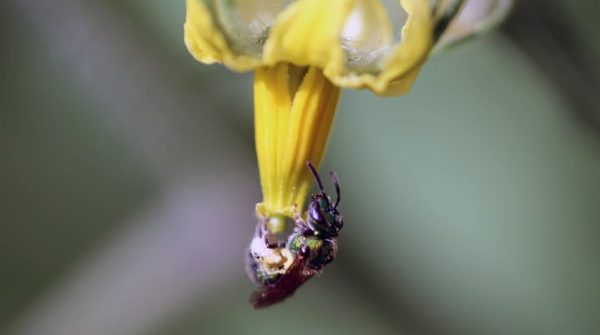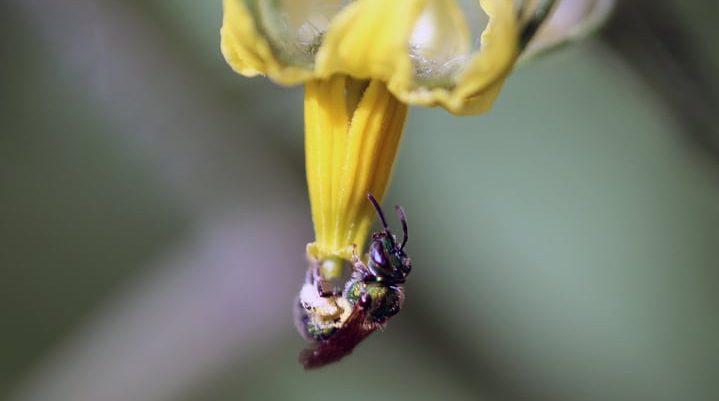Bees & Pollinators

Learn about the habits of the orchard mason bee and how to manage this native pollinator.
The orchard mason bee (Osmia lignaria) is a native nonsocial bee that is an efficient pollinator of early-season crops, including small and tree fruit, flowers, and vegetables. The female orchard mason bee is not a hive dweller; instead she prefers to nest within hollow stems, old woodpecker or insect holes, hollowed out trees, and even blocks of wood provided by interested gardeners and conservationists.
The orchard mason bee is described as a small blue to black metallic bee that is extremely gentle and unlikely to sting. Females and males emerge in the early spring as adults and immediately search for mates.

Orchard mason bee on a tomato bloom
Once mating is complete, the females search for a nesting site and begin collecting pollen and nectar. The female will make a single pollen/nectar ball and place it at the back of the nest. She then lays a female egg on the pollen ball and seals it off with mud. This process is repeated until she reaches the end of the nest where she lays a few male eggs. Males are considered expendable and are laid at the end of the tunnel. These eggs hatch within a short period of time, but the insects remain in the box as they continue to develop into adults throughout the winter. Adults emerge the next spring.
Mason bee emergence generally coincides with redbud tree blooming. Males generally emerge first but must wait for females to emerge to mate. If you have mason bees in a bee box, you can slightly delay their emergence by placing the box in a refrigerator for about a week.
Adult mason bees are only active for 4 to 6 weeks and then the adults die. Mason bee boxes need to be placed within 100 yards of a desired pollen source. Having a source of mud in close proximity to the nest is also beneficial for them. It is important that the boxes not be moved during active nesting. Once nesting has finished and each cell is capped with mud, move the box into a protected area to help prevent predator or parasite invasion. The box does need to be exposed to cold temperatures for the bees to properly break dormancy, so an unheated garage or shed would work fine. Be careful when transporting the box; the young insects are developing inside and you don’t want to injure them.
The bee box should be placed outside in March for the new adult bees to emerge and then for breeding use following emergence. The box should be mounted 4 to 6 feet above the ground on a post and face southeast. Choose a protected location, such as under an eave of a building or under a bit of cover, to shield the box from rain and extreme weather. After 3 to 4 years of use, the boxes should be replaced to prevent the natural build up of pathogens and parasites.
Christopher Becker, Regional Extension Agent, Home Grounds, Gardens, and Home Pests, and James Tew, Extension Bee Specialist
Reviewed October 2021, The Orchard Mason Bee, ANR-2140

